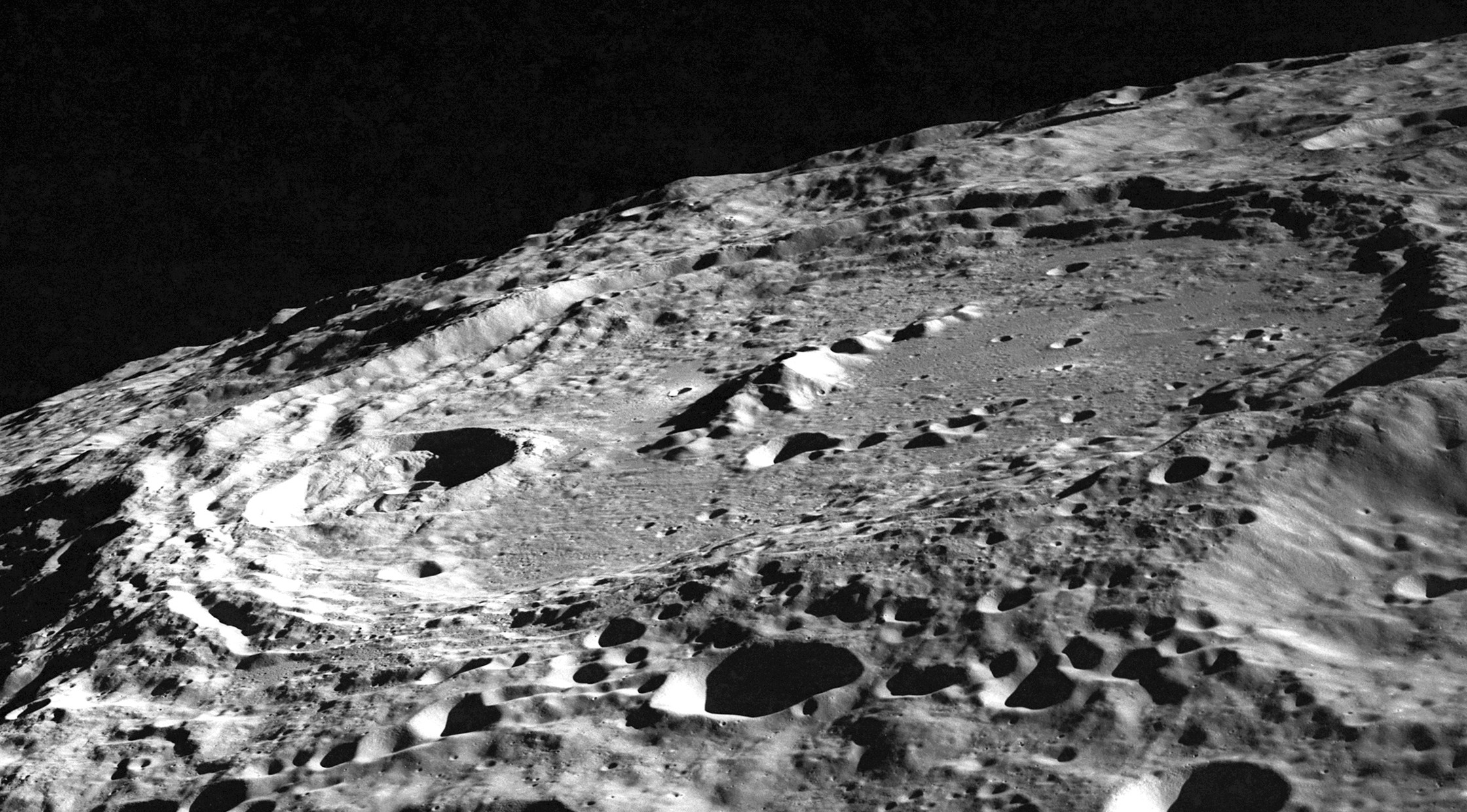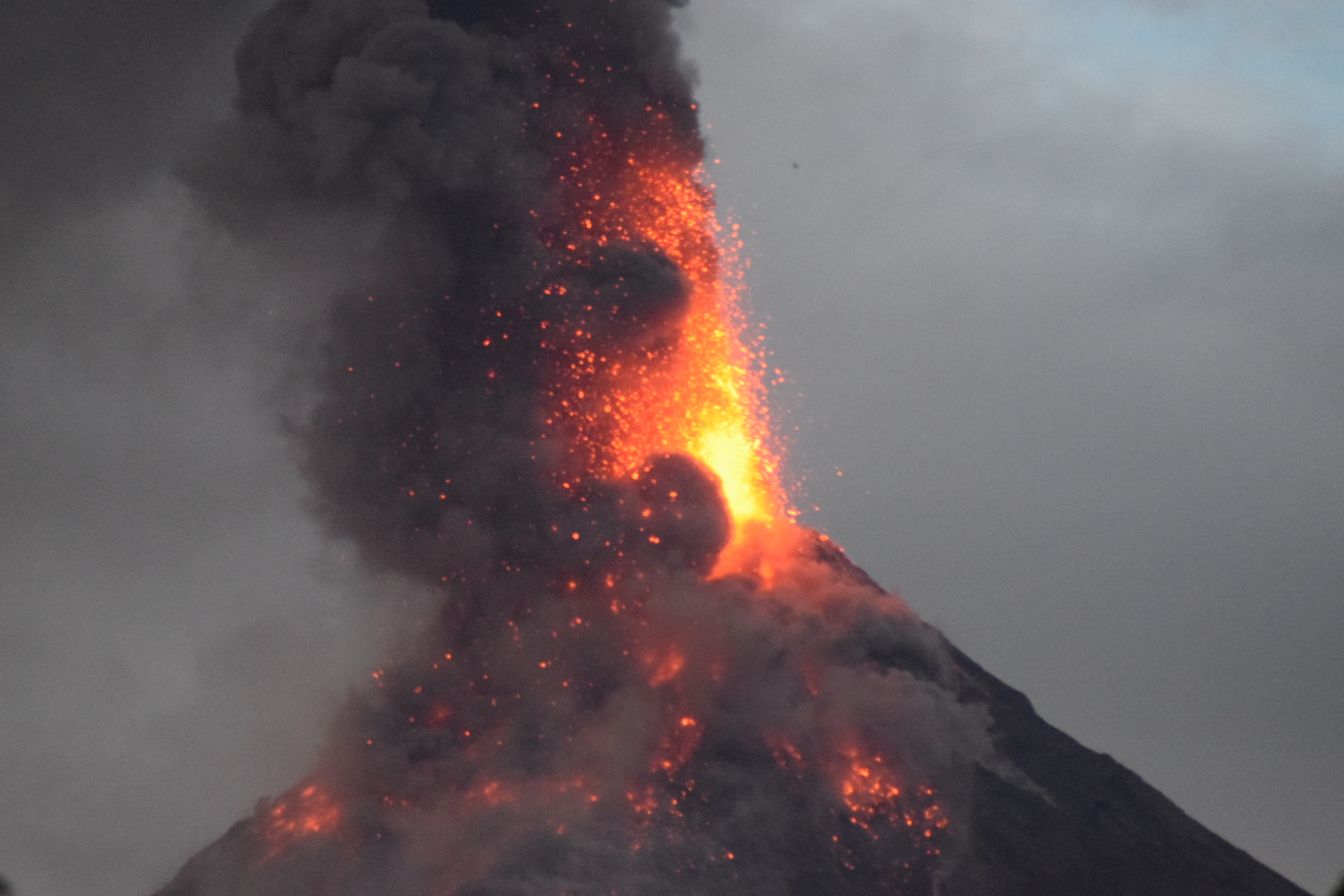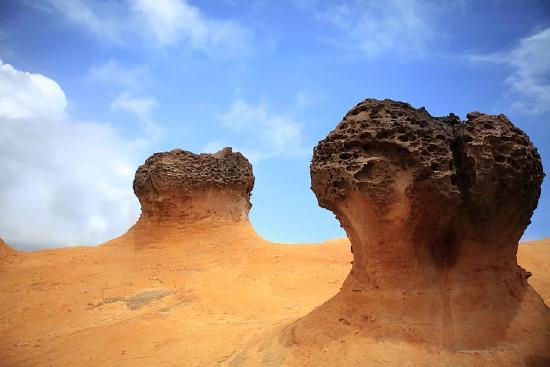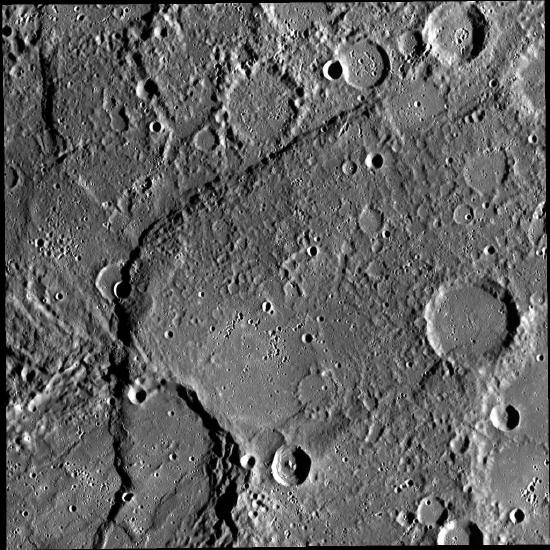9.4: Surface of Terrestrial Planets
( \newcommand{\kernel}{\mathrm{null}\,}\)
Several factors have shaped the surfaces of the terrestrial planets. For example, impacts by asteroids or comets have created impact cratering. In addition, Volcanism, the eruption of molten rock on the surface have created new crust material. Plate tectonics, the movement of crustal plates due to convective forces in the mantle have built up mountain ranges and pushed older crust back into the mantle. Finally, erosion from wind, water, or ice have worn away surface features.
9.4.1 Cratering
 Craters are formed by impacts.
Craters are formed by impacts.
 Keeler crater on the Moon.
Keeler crater on the Moon.
Most cratering happened soon after the solar system formed during the Late Heavy Bombardment period, in the first billion years after the formation of the planets. Craters formed by impacts tend to be about 10 times wider than the object that made them. As a rule, small craters greatly outnumber large ones. Because most cratering happened in the first billion years, we can generally conclude that a surface with many craters has not changed much in 3 billion years. For example, some areas of Moon are more heavily cratered than others while younger regions were flooded by lava after most cratering.
9.4.2 Volcanism
 Volcanic eruptions have shaped the surfaces of all four terrestrial planets.
Volcanic eruptions have shaped the surfaces of all four terrestrial planets.
Volcanism happens when molten rock (magma) finds a path through lithosphere to the surface. There are three major types of volcanoes: cinder cone volcanoes, composite/stratovolcanoes, and shield volcanoes. The thickest lava makes steep stratovolcanoes while cinder cones tend to produce more ash and dust than lava. Slightly runnier lava makes broad shield volcanoes. Runny also lava makes flat lava plains. Bodies like the Moon and Mars, with lower gravity, tend to have runnier lave, producing the giant shield volcanoes on Mars or the wide maria on the Moon. Volcanism also releases gases from the planet’s interior into the atmosphere, particularly carbon dioxide.
9.4.3 Tectonics
Convection of the mantle creates stresses in the crust called tectonic forces. Compression of crust creates mountain ranges while valleys can form where crust is pulled apart. Earth's continents slide around on separate plates of crust. The other terrestrial planets appear to lack any active plate tectonics. It is likely that liquid water on the surface is necessary to provide lubrication to keep subduction, the sliding of one plate beneath another, going. On Earth, subduction occurs on the ocean floor. On the other terrestrial planets, any water on the surface boiled away or frozen a long time ago. Without liquid water, subduction may have ceased, shutting down all the plate tectonics on planets like Mars and Venus. Also, smaller worlds cool off faster and harden earlier. Larger worlds (like Earth) remain warm inside, promoting volcanism and tectonics.
9.4.4 Erosion
 Erosion by wind and other forces can shape the surface of planets.
Erosion by wind and other forces can shape the surface of planets.
https:/www.pxfuel.com/en/free-photo-oubss;
Erosion is a blanket term for weather-driven processes that break down or transport rock. Processes that cause erosion include glaciers, rivers, and wind. For example. the Colorado River continues to carve Grand Canyon while glaciers carved the Yosemite Valley. In addition, wind wears away rock and builds up sand dunes in the deserts. Erosion can create new features such as deltas by depositing debris.
Larger worlds tend to have more erosion because their gravity retains an atmosphere. In addition, planets close to the Sun are too hot for rain, snow, ice and so have less erosion. Hot planets have more difficulty retaining an atmosphere while planets far from the Sun are too cold for rain, limiting erosion. We can then conclude that planets with liquid water have the most erosion. Also, planets with slower rotation have less weather, less erosion, and a weak magnetic field while planets with faster rotation have more weather, more erosion, and a stronger magnetic field.
Comparing the four terrestrial planets we can see their relative rates of erosion in the table below.
|
Planet |
Distance from the Sun |
Rotation |
Atmosphere |
Liquid water on the surface? |
Rate of Erosion |
|
Mercury |
Very close |
Slow |
None |
None |
None |
|
Venus |
Close |
Slowest |
Very thick |
None |
Little |
|
Earth |
Moderate |
Fastest |
Medium |
Yes |
Highest |
|
Mars |
Furthest |
Fast |
Very thin |
None |
Little |
9.4.5 Dating the Surfaces of planetary bodies
Since in many cases, the only information we have about the surface of planets and moons is images, astronomers date the surfaces of the terrestrial planets by counting craters. Astronomers assume that smoother areas, such as lunar maria, are younger because they were covered by relatively recent lava flows. Therefore, the more heavily cratered an area, the older it is. Crater counting, however, only gives us relative ages. Aside from the Earth, the only body that we have been able to date using radiometric techniques is the Moon. We, therefore, have been able to conclude that the lunar surface is much older than the Earth’s.
In comparison, all we know about Mercury is from the Mariner and Messenger probes. These images have shown that Mercury is heavily cratered and lacks large maria. This indicates that the surface of Mercury is likely as old as the oldest areas of the Moon.
 The surface of Mercury is heavily cratered, much like the Moon, indicating its surface may be as old as the Moon's.
The surface of Mercury is heavily cratered, much like the Moon, indicating its surface may be as old as the Moon's.
https:/www.flickr.com/photos/nasamarshall/5961481338;
The cloudy atmosphere of Venus has made it difficult to map its surface. Since visible light cannot penetrate Venus’ thick cloud layers, we have used radar give us a picture of what the surface of Venus looks like. One thing the Magellan probe found was that the force of gravity is stronger over highlands and mountains. This is due to there being more mass concentrated there. Earth does not have this variation in gravity due to the Archimedes Principle. This states that mass of any object is equal to the mass of the fluid it displaces. The continents displace an equal mass of fluid in the mantle, keeping the overall mass balanced, as a result, gravity remains uniform. The fact that on Venus, the mass of the highlands does not appear to displace any fluid beneath it indicates its mantle is more solid. This is probably why Venus lacks plate tectonics.
 The surface of Venus as mapped by radar from orbit.
The surface of Venus as mapped by radar from orbit.
Compared to Venus, we have a much more complete map of the surface of Mars thanks to the several orbiters that have taken images of the red planet since the 1970s as well as the numerous landers and rovers that have explored its surface. Using crater counts and other methods, planetary scientists divide the surface of Mars into three epochs.
- The Noachian epoch (4.3–3.5 billion years ago)
- The Hesperian epoch (3.5–1.8 billion years ago)
- The Amazonian epoch (1.8 billion years ago until the present).
There is quite a bit of uncertainty in these dates for two main reasons. First, we do not have the independent ages from radioactive dating that we do for the Moon. Second, we cannot be sure that Mars received the same bombardment as the Moon did.
Examination of the surface of Mars has found features that indicate past river flows are found in the oldest (Noachian) areas of Mars. This tells us Mars was wetter in the past. Also, the northern hemisphere is also 6 km lower than the southern hemisphere, which many planetary scientists could it have been home to an ocean back in the Noachian epoch.
The surface of the northern hemisphere is also younger, having mostly formed during the Amazonian epoch (2 billion years ago). Radar images, however, indicate that there is an older, crater-filled surface beneath the current surface of the northern hemisphere. The elevation difference between north and south must have occurred early in the history of the Mars.
Spectroscopic analysis of the Martian surface has found that the older (Noachian and Hesperian) regions of Mars are mostly basalt. The Amazonian region is mostly iron oxide, which gives Mars is characteristic red color. There is no evidence of hydrated minerals in the Amazonian regions, indicating Mars has been dry for at least 2 billion years. Opportunity first discovered sandstone, sulfates, and salts in Endurance Crater. These are minerals that form in the presence of water, indicating the presence of water at one time. Opportunity also found rocks that contain hematite that scientists have nicknamed “blueberries” due to their size and the color they appear on the images. On Earth, hematite only forms in the presence of water. Rovers have also found phyllosilicates (simple clays) on the Martian surface.
The Martian lithosphere is thicker than Earth's due to its smaller size, which has promoted more rapid cooling. This allows Martian mountains to grow higher than on Earth because they have more support. Thick lithospheres also partially explain the lack of plate tectonics in the rest of the Solar System — a planet's lithosphere must be thin enough to break into separate plates.
 With orbiters, landers, and rovers, we have mapped the surface of Mars in extraordinary detail.
With orbiters, landers, and rovers, we have mapped the surface of Mars in extraordinary detail.







